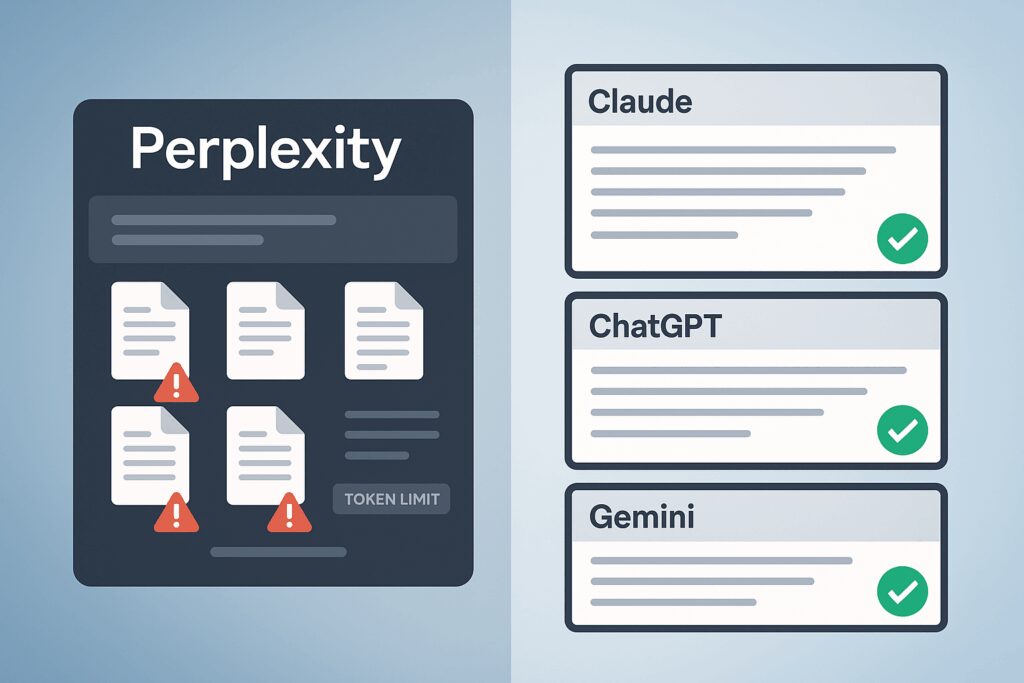Yesterday, I signed up for Perplexity Enterprise for my entire team. Today I canceled it. After spending 24 hours testing Perplexity’s features against our actual workflow needs, I discovered critical limitations that make it unsuitable for professional content creation and marketing teams.
While Perplexity markets itself as a comprehensive AI research assistant that can replace multiple subscriptions, my experience reveals significant gaps between its promises and practical performance. Here’s what went wrong and why businesses should think twice before making Perplexity their primary AI tool.
Table of Contents
ToggleWhat Initially Attracted Me to Perplexity
Two features made me immediately want to switch our entire team to Perplexity Enterprise:
Multi-Model Access in One Platform As someone already paying for Claude, ChatGPT, and Gemini subscriptions for my team, Perplexity’s ability to access multiple models through one interface seemed like the perfect solution. Each model has different strengths, and having them all in one place appeared to offer both convenience and cost savings.
Spaces Feature for Team Collaboration Perplexity Spaces work similarly to Custom GPTs, Claude Projects, or Gemini Gems. Since 90% of our team’s AI usage happens inside these project-based tools, I was excited about Perplexity’s team sharing capabilities – something you can’t do with Claude and Gemini projects.
We create brand ambassador projects for each client, loading them with everything about that particular client. This process has been our biggest AI advantage, allowing us to create content and develop strategy that truly represents each brand.
@tjrobertson52 From excited to canceled in 24 hours 😅 Why Perplexity Enterprise didn’t work for my team #PerplexityAI #AITools #TechReview #BusinessAI #AIFail
♬ original sound – TJ Robertson – TJ Robertson
The Context Window Problem
The first major issue I discovered was Perplexity’s severely limited context window. Perplexity’s “Spaces” feature caps out at around 32,000 tokens on the highest paid plan, while Claude itself supports up to 200,000-500,000 tokens.
This isn’t a minor technical detail – it’s the fundamental reason models have become dramatically more useful in recent months. In Claude, I can load hundreds of thousands of words of content about each client. Every prompt has access to all of that context and utilizes it efficiently.
How Perplexity’s Retrieval System Fails Perplexity uses retrieval-augmented generation, meaning it only feeds the model content it thinks is relevant to your specific query. As one analysis explained, “Perplexity is retrieving only the content that it thinks is relevant for your query, and to save on money, it really skimps on how much it returns.”
This approach creates generic outputs because only surface-level information gets used, even when comprehensive brand information is loaded into the Space. The brand ambassadors I created simply weren’t representing clients accurately – they produced the same generic responses I could get from any AI without context.
Lost Platform Infrastructure Through API Calls
The second critical problem is that Perplexity calls other models through their APIs rather than through the models’ native platforms. This means you lose all the built-in processing that native platforms provide.
Real-World Example: Google Ads Copy I tested this by asking both Claude’s native platform and Perplexity (using the same Claude model) to write Google Ads headlines and descriptions. The results were telling:
- Claude’s native platform: All headlines and descriptions came out just under the required character limits
- Perplexity using Claude: Half the headlines exceeded limits, and descriptions were more than double the maximum allowed characters
The native Claude platform includes additional processing steps to check and reformat responses, while Perplexity’s API calls bypass these quality controls entirely.
When Perplexity Actually Works Well
To be fair, Perplexity excels in specific use cases. It’s excellent for research, fact-checking, and quick information lookup. The platform shines when you need fast, sourced answers to straightforward questions.
Most people who rave about Perplexity are using it for learning and research – and for those purposes, it’s genuinely useful. Perplexity specializes in “fast, transparent sourcing with a stronger focus on facts, less creative embellishment and more core information.”
Why Content Teams Need Native Platforms
Professional content creation requires three things Perplexity can’t deliver:
- Large context windows for comprehensive brand understanding
- Full context utilization rather than selective retrieval
- Platform-level quality controls for consistent formatting and constraints
For content creation requiring nuance, creativity, or strict adherence to style and brand guidelines, Perplexity’s limitations become apparent. Teams consistently report that Perplexity’s outputs sound generic even when brand information is provided.
The Bottom Line for Business Users
Perplexity works well as a research assistant, but it cannot replace dedicated subscriptions for professional content creation. While it offers unmatched flexibility with multiple models in one place, its small context limit and selective retrieval make it unsuitable for complex, brand-driven work.
For marketing teams and content creators, the best approach is using Perplexity for initial research and fact-gathering, then switching to native platforms like Claude for actual content creation and strategy development.
Ready to Optimize Your AI Workflow?
If you’re struggling to get consistent, on-brand results from your AI tools, you’re not alone. At TJ Digital, we’ve spent months developing AI workflows that actually work for marketing teams – including the brand ambassador systems I mentioned in this article.
Whether you need help setting up proper AI optimization strategies or want to learn how we’re using AI to create content that ranks in both search engines and large language models, contact us for a free consultation to see how we can help scale your marketing efforts efficiently.

